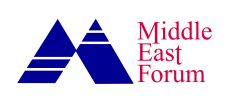Director for research at the Washington Institute for Near East Policy, Patrick Clawson is also senior editor of the Middle East Quarterly. He has written widely on Middle Eastern topics, especially about Iran and economics. Mr. Clawson has worked at the International Monetary Fund and the World Bank. In March 2001, he spoke to the Middle East Forum about current economic trends in the Middle East.
When I speak about the “Middle East” today, I am excluding Israel and Turkey. Both countries are democracies, fully integrated into the global economy, and do not fit the points that follow.
An Economic Overview
Economically, the Middle East is the odd man out in the world race to globalize; it is progressively disengaging from the world economy.
The region grew at only half the rate of other developing countries during the 1990s. This statistic is particularly salient given the catastrophic performance of the former Soviet bloc during that same decade. In fact, the Middle East is the only region in the world where foreign trade has grown at a slower rate than its output. Further, its share of world exports fell from 3.1 percent in 1990 to 1.9 percent in 1998.
A good indicator of where the Middle East stands vis-à-vis the international community is its connectivity to the internet. The average number of internet subscribers per 10,000 people in the US is now 1,940. In sub-Saharan Africa, it’s 2.7. In the Middle East, it is just .06.
Another indicator is foreign investment. Due to a complete lack of faith in its domestic economic infrastructure, the Middle East holds the largest share of wealth abroad in the world, with $350 billion currently collecting interest abroad, rather than in local financial institutions.
Oil is the saving grace of the Middle East, but it often clouds the picture. OPEC’s oil export revenue has risen steadily from $99 billion in 1998 to $211 billion in 2000. However, this boom is somewhat reminiscent of the dot-com bubble; this kind of growth cannot be sustained.
Standards of Living
The standard of living in the Middle East is even worse than the economic data suggest. The literacy rate in the region (63 percent) is roughly equivalent to that of sub-Saharan Africa. The average population growth rate in the Middle East is also second only to sub-Saharan Africa, with a rate of 2.2 percent between the years of 1990-1999.
The worst economic performance of all Middle East states is Iraq. From 1958 and the rise of the Ba`th regime until 1979 and the rise of Saddam, per-capita income multiplied four-fold. In the twenty-two years Saddam has been in power, per-capita income dropped back to its 1958 level.
Political and Human Rights
The political and human rights records of Middle East states are commensurate with Middle Eastern economic figures. According to Freedom House, five of the world’s eleven most repressive countries are members of the Arab League. Contrarily, not one of the twenty-three members of the Arab League was deemed “free” in that same Freedom House report. And finally, according to the U.S. State Department, three of the world’s most severe violators of religious freedoms are in the Middle East, with another next door in Afghanistan. Indeed, improved human rights is an essential first step for the Arab world to create free markets and subsequently join the global economy.
Middle East Violence
The Middle East economy is burdened by the highest military spending in the world. In 1997, the Middle East spent 7 percent of its GNP on weapons, as opposed to the 2.5 percent world average. Armed forces in the region constitute 2.8 percent of the labor force, as compared to the 0.8 percent world average. And finally, arms constituted 14.5 percent of all Middle East imports, versus a 1 percent average worldwide.
The Middle East is a region plagued by war. In the last half-century, the region experienced numerous civil wars and territorial conflicts. Five of the world’s seven state sponsors of terrorism are in the Middle East: Syria, Libya, Iraq, Iran and Sudan.
The Middle East is also infamous for its active terrorist network, including Usama bin Ladin’s al-Qa`ida organization. The Middle East has witnessed the world’s only documented uses of chemical weapons in the last generation: Iraq (against Iran), Iran (against Iraq), Libya (against Chad) and Egypt (against North Yemen).
With comparatively high level of violence, and the usual economic damages sustained by such violence, the economies of the Middle East have suffered terribly. Less emphasis on military spending and more focus on the development of market economies may finally allow the Middle East to catch up to the twenty-first century.
Bright Spots
On a brighter note, Egypt’s gross national product between 1990 and 1999 went up 2.5 percent. Israel’s GNP saw an increase of 2.1 percent and Turkey, 2.6 percent. Concurrently, the Gulf states of Qatar, Bahrain and Kuwait all have exhibited signs of democratic reform, while Iran has been demonstrating efforts at reform, as well. Indeed, the Middle East has great potential for improvement.
Conclusion
While many analysts assert that the end of the Arab-Israeli conflict would hearken a new age of prosperity, I assert this may reveal an explosive array of political, social, economic and military problems that have been masked for so long.
In the Middle East, democratization, human rights and free-market economic principles have taken a back seat to the peace efforts between Israel and its autocratic neighbors, not to mention the importance of securing access to Gulf oil. While this policy may have been wise in the past, it may soon be rendered obsolete by its own success. The West must drop the kid-glove approach, and promote the same standards in the Middle East that it expects from the rest of the globe. This is best for the Middle East economy, for the peoples of the region, and for the world at large.
Summary account by Jonathan Schanzer, a research associate at the Middle East Forum.


